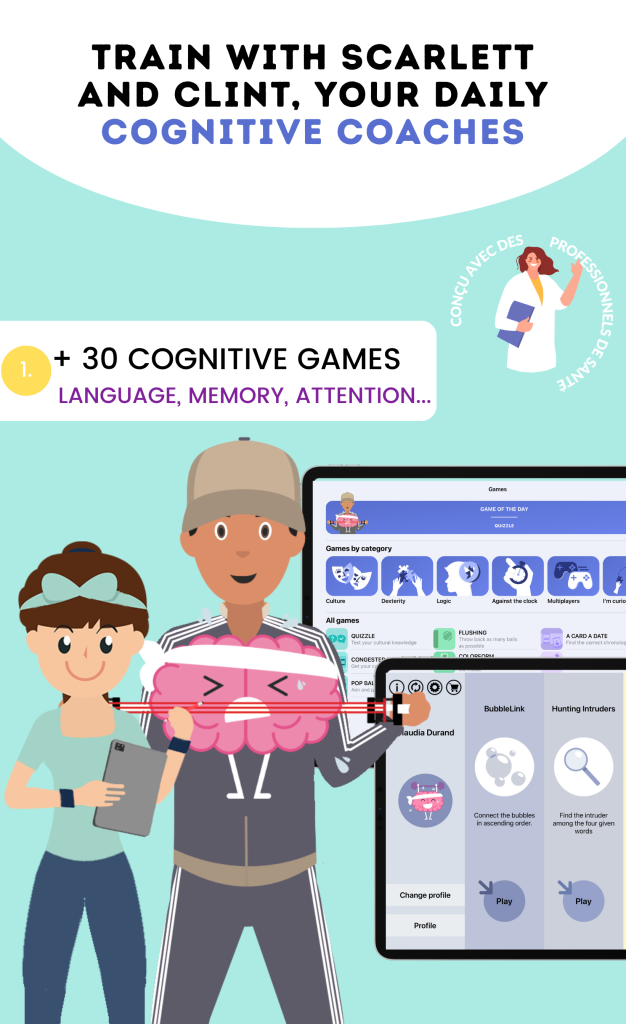In our journey of supporting families and professionals, we are confronted with one of the most distressing situations related to Alzheimer’s disease: the escape, or more precisely, wandering. This is not a voluntary attempt to escape, but rather the manifestation of an internal compass that has gone awry, a confused quest led by a mind that has lost its bearings. The fear that grips a caregiver when they realize their loved one is no longer where they should be is a chilling feeling. That is why we have developed clear protocols and support tools, not only to react in case of a crisis but, above all, to prevent it.
At the heart of our approach is training. During our training sessions, such as the one we offer to learn how to stimulate and create connections, we emphasize that understanding behavior is the first step to preventing it. A person with Alzheimer’s disease does not wander out of defiance. They follow a logic of their own, dictated by their memories, emotions, and unexpressed needs. Our mission is to give you the keys to decipher this logic and build a safe and caring environment. This article is an extension of that commitment: a practical guide to help you weave a safety net around your loved one and know how to react if, despite everything, they were to get lost.
To act effectively, we must first understand. Wandering is never a trivial or random act. It is the consequence of deep internal confusion, a need, or anxiety. Imagine for a moment being in a world where familiar faces seem foreign, where yesterday’s routines no longer make sense today, and where the words to express a simple pain or desire escape you. In this cognitive fog, walking sometimes becomes the only possible response, an attempt to regain a semblance of control or a fragment of one’s former life.
Common Triggers of Wandering
The reasons that drive a person to wander are multiple and very personal, but we can identify recurring patterns. Understanding these triggers is the first step towards prevention.
- The search for a bygone past: Very often, the person is not trying to escape the present but to return to the past. They may want to “go home” (even if they are already there, they think of their childhood home), go “pick up the kids from school” (even if they have been adults for decades), or go to their former workplace. These destinations are anchored in their long-term memory, which often remains preserved longer than recent memory.
- The response to an unmet need: The inability to communicate physical discomfort is a powerful driver of wandering. Hunger, thirst, the need to go to the bathroom, pain, or discomfort (tight clothing, a room that is too hot) can generate agitation that manifests as a need to move, to “go out” to find a solution.
- Anxiety and stress: An environment that is too noisy, too chaotic, the presence of too many unfamiliar people, or even a feeling of loneliness or abandonment can provoke intense anxiety. Flight then becomes a defense mechanism to escape this situation perceived as threatening.
- Boredom and lack of stimulation: A person left without activity or interaction may start to wander simply out of lack of stimulation. The body needs to move, the mind needs to be occupied. Without a specific goal, walking becomes an end in itself.
The Role of Environment and Routine
The environment plays a crucial role. An inadequately adapted living space, where the landmarks are blurred, can increase the risk of wandering. A long, empty hallway may invite walking, a front door in plain sight may be perceived as an exit to take. The loss of the sense of time is also an aggravating factor. The onset of night, for example, is a moment of great anxiety for many (the “sundowning syndrome”), where confusion intensifies and the urge to leave can become irresistible.
Routine is the anchor that keeps the person connected to the present. A regular schedule for meals, bathing, activities, and bedtime helps structure the day and reduce anxiety. Any break in this routine (a medical appointment, a visit from a stranger) can be a disruptive element and a potential trigger. That is why we emphasize so much in our training the importance of creating positive and reassuring rituals.
Prevention: Setting Up a Safety Net
The best way to manage a wandering incident is to ensure it does not occur. Prevention is a continuous effort that combines environmental adaptation, cognitive and emotional stimulation, and communication. It is about building a secure cocoon, a “home” that is a refuge and not a prison.
Securing the Home
Securing the home does not mean turning it into a fortress, but rather creating a space where risks are minimized discreetly and intelligently. It is necessary to find a balance between safety and preserving the dignity and freedom of movement of the person.
- The doors: The front door is the most critical element. You can install complex locks that are difficult to manipulate or placed high/low on the door, out of the usual line of sight. Another trick is to “camouflage” the door by painting it the same color as the wall or placing a large curtain in front of it. Discreet door alarms can alert you if it is opened.
- New technologies: GPS tracking devices, in the form of a watch, pendant, or insole to slip into the shoe, can be a reassuring solution. They allow for quick location of the person if they were to get lost, thus reducing search time and associated risks.
- Information: Ensure that your loved one always has some form of identification on them: an engraved bracelet, a card in their wallet, or a label sewn into their clothing, with their name and a contact phone number. Specify “I have memory problems, please contact this number.”
Creating a Stimulating and Soothing Environment
An occupied mind is less prone to wandering. Boredom and anxiety, as we have seen, are major triggers. The goal is to offer suitable activities that give purpose to the day and strengthen social ties. This is precisely the philosophy behind our applications.
This is where our tools like SCARLETT, our memory games on tablet, make perfect sense. We designed them not as mere exercises but as bridges for communication. A musical quiz, a proverb recognition game, or a reconstruction of family photos not only stimulate memory. They create a moment of sharing, a dialogue, a smile. This moment of connection anchors the person positively in the present. By sharing this activity with them, you offer quality attention that meets their need for recognition and reduces their anxiety. Less anxious and more engaged, they will have fewer reasons to seek an escape.
The Importance of Communication and Identifying Needs
Sometimes, wandering is a silent cry, the expression of a need that the person can no longer articulate with words. The frustration of not being understood is immense and can lead to agitation behaviors. How can a person say “I have a stomach ache” or “I’m thirsty” when the words escape them?
To address this challenge, we developed MY DICTIONARY. This simple tool on tablet or smartphone uses images and pictograms to help people with cognitive disorders express their fundamental needs: eating, drinking, feeling cold, experiencing pain, etc. By pointing to an image, the person can communicate an essential need. By defusing frustration at its source, you prevent the agitation that could lead to wandering. It is a simple yet powerful tool to keep the dialogue open when words are no longer sufficient.
The Alert Protocol: What to Do in the First Minutes?

Despite all precautions, a wandering incident can occur. The speed of response is crucial. The first minutes and the first hour are decisive. It is essential to have a clear action plan to avoid succumbing to panic and to act methodically.
Initial Assessment: Don’t Panic, But Act Quickly
The first thing to do is to stay calm, even if it is the hardest thing in the world. Your clarity of mind is your best asset.
- Immediate Check: First, search inside and around the living area. Look in all rooms, closets, the bathroom, the basement, the attic, the garden, the garage. It often happens that the person has simply hidden or fallen asleep in an unusual place.
- Information Gathering: If the person is not on site, immediately note the time you noticed their disappearance. Try to remember the last time you saw them and what they were wearing (colors, type of clothing, shoes, were they wearing a coat?). Prepare a recent photo.
Mobilizing the Immediate Circle
Act quickly. Do not wait thinking that the person will return on their own. Every minute counts. Immediately contact family members, close friends, and neighbors. Give them a precise description and divide up the immediate search areas: the surrounding streets, the nearest park, the local shops.
When and How to Contact Authorities?
Do not hesitate or feel ashamed to contact the police (Police or Gendarmerie by dialing 17). A disappearance of a vulnerable person is always taken seriously. We advise you to call them if you have not found your loved one within 15 to 30 minutes of starting your search.
When you call them, be ready to provide the following information clearly and concisely:
- Full Identity: Name, first name, age, date of birth.
- Physical Description: Height, build, hair and eye color, distinguishing features (glasses, scar, particular gait).
- Clothing: The most precise possible description of the clothing.
- Medical Information: Specify that this is a person with Alzheimer’s disease, their general health status, and if they need urgent medication.
- Circumstances of Disappearance: Time and place last seen, what they were doing just before.
- Possible Destinations: Mention their former addresses, workplaces, or any place they have recently mentioned.
Providing a recent photo will be invaluable. The authorities will then be able to disseminate a report quickly and effectively.
Active Search: Organizing Searches Methodically
Once the alert has been given, the search is organized. It is not about running in all directions but coordinating efforts to cover as much ground as possible logically.
Defining Priority Search Areas
Try to put yourself in the person’s shoes. Where would their memory guide them? Searches should prioritize places that have meaning for them.
- The Paths of Memory: Think of places from their past. The old family home, the school they attended, the company they worked for, even if these places are several kilometers away. People with the disease can sometimes travel surprisingly long distances, guided by a powerful memory.
- Recent Habits: Where do they like to walk? What is their usual route to the bakery or the park? Explore these familiar routes.
- Attraction and Danger Points: Check parks, public squares, churches, train stations. Also consider risky areas like riverbanks, ponds, railways, or busy roads.
The Tools and Resources at Your Disposal
In addition to the action of the police or gendarmerie, other resources can be mobilized. Support associations for families, such as France Alzheimer, can offer valuable advice and moral support. They have extensive experience in these situations and can help you remember everything. Social media can be used to disseminate a missing person notice (with the family’s consent and ensuring not to share overly personal information), targeting local groups in your city or neighborhood.
The Role of the Community: Unity is Strength
Do not hesitate to inform local shopkeepers, the pharmacist, the doctor, the mailman. Show them a photo. These are people who are often outside and may have seen your loved one. The collective vigilance of a community is an invaluable help. People are often much more willing to help than one might think, especially when it comes to a vulnerable person.
After the Wandering: The Return and Analysis for the Future
The moment you find the person is an immense relief, but managing the situation does not stop there. The post-wandering phase is an essential step for the well-being of the person and for strengthening future prevention.
Welcoming the Person Without Judgment
When your loved one is found, they are likely tired, scared, confused, and perhaps even hypothermic or dehydrated. The top priority is to reassure them. Avoid blame, accusatory questions (“But why did you leave?”). The person probably has no logical answer to give you, and that would only increase their anxiety. Welcome them warmly, offer them a hot drink, a blanket, and speak to them in a calm voice. Have them examined by a doctor to ensure they are not injured.
Analyzing the Event to Better Prevent
Once everyone has calmed down, it is important to take stock, not to find a culprit, but to understand. Try to reconstruct the sequence of events that preceded the wandering.
- Was there a change in routine that day?
- Did the person show signs of agitation, anxiety, or pain?
- Had they expressed a particular need verbally or non-verbally?
- Was there a triggering element in the environment (a loud noise, a visit)?
This analysis will allow you to identify any flaws in your safety net and adjust your prevention strategies. Perhaps it is necessary to reinforce the security of a door, or to be more attentive to signs of pain, or to enrich the days with more structured activities and moments of sharing.
Taking Care of Yourself as a Caregiver
Finally, do not forget to take care of yourself. A wandering incident is a traumatic event for the caregiver. Stress, fear, and guilt can be overwhelming. It is essential not to remain alone with these emotions. Talk about it with your family, friends, or join a support group for caregivers. You can also find information and support on official portals like the For the Elderly government website. Recognizing your own fatigue and stress is the first step to continuing to support your loved one calmly and effectively.
We firmly believe that information, prevention, and the right tools can transform anxiety into vigilance, and fear into thoughtful action. The journey with Alzheimer’s disease is a path filled with unexpected events, but by being prepared, supported, and equipped, you never walk alone.
In the context of the discussion on “Escape of an Alzheimer’s Person: Alert Protocol and Search”, it is interesting to consider the tools and resources available for healthcare professionals, particularly speech therapists, who play a crucial role in supporting people with neurodegenerative diseases. A relevant article on this subject can be found on the Dynseo website, which offers tailored solutions for speech therapists. To learn more about these resources, you can consult this article dedicated to speech therapists.





